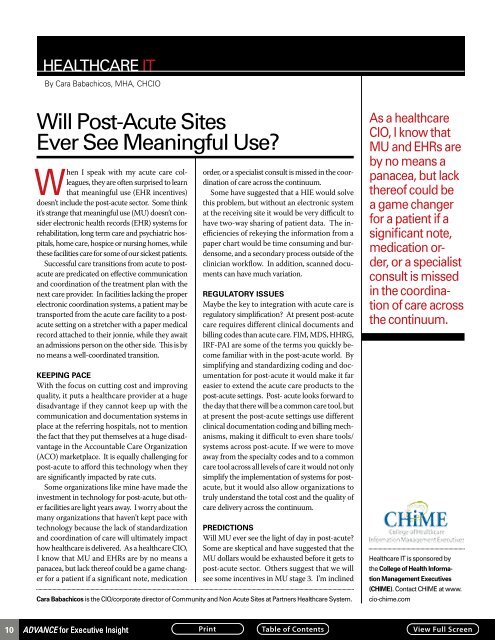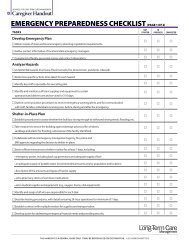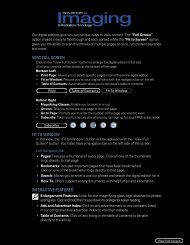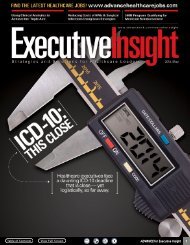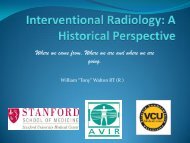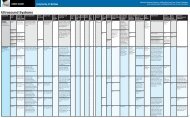ADVANCE for Executive Insight 1 ADVANCE for Executive Insight
ADVANCE for Executive Insight 1 ADVANCE for Executive Insight
ADVANCE for Executive Insight 1 ADVANCE for Executive Insight
- No tags were found...
You also want an ePaper? Increase the reach of your titles
YUMPU automatically turns print PDFs into web optimized ePapers that Google loves.
Healthcare IT<br />
By Cara Babachicos, MHA, CHCIO<br />
Will Post-Acute Sites<br />
Ever See Meaningful Use?<br />
When I speak with my acute care colleagues,<br />
they are often surprised to learn<br />
that meaningful use (EHR incentives)<br />
doesn’t include the post-acute sector. Some think<br />
it’s strange that meaningful use (MU) doesn’t consider<br />
electronic health records (EHR) systems <strong>for</strong><br />
rehabilitation, long term care and psychiatric hospitals,<br />
home care, hospice or nursing homes, while<br />
these facilities care <strong>for</strong> some of our sickest patients.<br />
Successful care transitions from acute to postacute<br />
are predicated on effective communication<br />
and coordination of the treatment plan with the<br />
next care provider. In facilities lacking the proper<br />
electronic coordination systems, a patient may be<br />
transported from the acute care facility to a postacute<br />
setting on a stretcher with a paper medical<br />
record attached to their jonnie, while they await<br />
an admissions person on the other side. This is by<br />
no means a well-coordinated transition.<br />
Keeping Pace<br />
With the focus on cutting cost and improving<br />
quality, it puts a healthcare provider at a huge<br />
disadvantage if they cannot keep up with the<br />
communication and documentation systems in<br />
place at the referring hospitals, not to mention<br />
the fact that they put themselves at a huge disadvantage<br />
in the Accountable Care Organization<br />
(ACO) marketplace. It is equally challenging <strong>for</strong><br />
post-acute to af<strong>for</strong>d this technology when they<br />
are significantly impacted by rate cuts.<br />
Some organizations like mine have made the<br />
investment in technology <strong>for</strong> post-acute, but other<br />
facilities are light years away. I worry about the<br />
many organizations that haven’t kept pace with<br />
technology because the lack of standardization<br />
and coordination of care will ultimately impact<br />
how healthcare is delivered. As a healthcare CIO,<br />
I know that MU and EHRs are by no means a<br />
panacea, but lack thereof could be a game changer<br />
<strong>for</strong> a patient if a significant note, medication<br />
order, or a specialist consult is missed in the coordination<br />
of care across the continuum.<br />
Some have suggested that a HIE would solve<br />
this problem, but without an electronic system<br />
at the receiving site it would be very difficult to<br />
have two-way sharing of patient data. The inefficiencies<br />
of rekeying the in<strong>for</strong>mation from a<br />
paper chart would be time consuming and burdensome,<br />
and a secondary process outside of the<br />
clinician workflow. In addition, scanned documents<br />
can have much variation.<br />
Regulatory Issues<br />
Maybe the key to integration with acute care is<br />
regulatory simplification? At present post-acute<br />
care requires different clinical documents and<br />
billing codes than acute care. FIM, MDS, HHRG,<br />
IRF-PAI are some of the terms you quickly become<br />
familiar with in the post-acute world. By<br />
simplifying and standardizing coding and documentation<br />
<strong>for</strong> post-acute it would make it far<br />
easier to extend the acute care products to the<br />
post-acute settings. Post- acute looks <strong>for</strong>ward to<br />
the day that there will be a common care tool, but<br />
at present the post-acute settings use different<br />
clinical documentation coding and billing mechanisms,<br />
making it difficult to even share tools/<br />
systems across post-acute. If we were to move<br />
away from the specialty codes and to a common<br />
care tool across all levels of care it would not only<br />
simplify the implementation of systems <strong>for</strong> postacute,<br />
but it would also allow organizations to<br />
truly understand the total cost and the quality of<br />
care delivery across the continuum.<br />
Predictions<br />
Will MU ever see the light of day in post-acute?<br />
Some are skeptical and have suggested that the<br />
MU dollars would be exhausted be<strong>for</strong>e it gets to<br />
post-acute sector. Others suggest that we will<br />
see some incentives in MU stage 3. I’m inclined<br />
Cara Babachicos is the CIO/corporate director of Community and Non Acute Sites at Partners Healthcare System.<br />
As a healthcare<br />
CIO, I know that<br />
MU and EHRs are<br />
by no means a<br />
panacea, but lack<br />
thereof could be<br />
a game changer<br />
<strong>for</strong> a patient if a<br />
significant note,<br />
medication order,<br />
or a specialist<br />
consult is missed<br />
in the coordination<br />
of care across<br />
the continuum.<br />
Healthcare IT is sponsored by<br />
the College of Health In<strong>for</strong>mation<br />
Management <strong>Executive</strong>s<br />
(CHIME). Contact CHIME at www.<br />
cio-chime.com<br />
10 <strong>ADVANCE</strong> <strong>for</strong> <strong>Executive</strong> <strong>Insight</strong>


